Shaivism
|
Part of a series on |
 |
|
Beliefs and practices
Dharma · Artha · Moksha · Karma · Samsara |
|
Scriptures
Vedas |
|
Related topics
Hinduism by country |
|
|
Shaivism, also spelled "Saivism," names the oldest of the four sects of Hinduism. Followers of Shaivism, called "Shaivas," and also "Saivas" or "Saivites," revere Shiva as the Supreme Being. Shaivas believe that Shiva is All and in all, the creator, preserver, destroyer, revealer and concealer of all that is. Shaivism is widespread throughout India, Nepal, and Sri Lanka, mostly. Notable areas of the practice of Saivism also include parts of Southeast Asia like Malaysia, Singapore, and Indonesia.
Contents |
History
It is very difficult to determine the early history of Shaivism.[1] The Śvetāśvatara Upanishad (400 - 200 BCE)[2] is the earliest textual exposition of a systematic philosophy of Shaivism.[3] As explained by Gavin Flood, the text proposes:
... a theology which elevates Rudra to the status of supreme being, the Lord (Sanskrit: Īśa) who is transcendent yet also has cosmological functions, as does Śiva in later traditions.[4]
During the Gupta Dynasty (c. 320 - 500 CE) Puranic religion developed and Shaivism spread rapidly, eventually throughout the subcontinent, spread by the singers and composers of the Puranic narratives.[5]
General features
Sacred ash came to be used as a sign of Shaivism. Devotees of Shiva wear it as a sectarian mark on their foreheads and other parts of their bodies with reverence. The Sanskrit words bhasma[6] and vibhuti[7] can both be translated as "sacred ash".
Major schools
Shaivism has many different schools showing both regional variations and differences in philosophy.[8] Shaivism has a vast literature that includes texts representing multiple philosophical schools, including non-dualist (abheda), dualist (bheda), and non-dual-with-dualism (bhedābheda) perspectives.[9]
Alexis Sanderson's review of Shaivite groups makes a broad distinction into two groups, with further subdivisions within each group:[10]
- Vedic, Puranic.
- Non-Puranic. These devotees are distinguished by undergoing initiation (dīkṣa) into a specific cult affiliation for the dual purposes of obtaining liberation in this life (mukti) and/or obtaining other aims (bhukti). Sanderson subdivides this group further into two subgroups:
-
- Those which follow the outer or higher path (atimārga), seeking only liberation. Among the atimārga groups two are particularly important, the Pāśupatas and a sub-branch, the Lākula, from whom another important sect, the Kālāmukhas, developed.[11]
- Those which follow the path of mantras (mantramārga), seeking both liberation and worldly objectives.
The following are concise summaries of some of the major schools of Shaivism, along with maps showing the primary areas of origin or present-day influence and concentration of each school in areas of the Indian subcontinent.
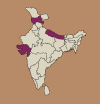
Pashupata Shaivism: The Pashupatas (Sanskrit: Pāśupatas) are the oldest named Shaivite group.[12] The Pashupatas were ascetics.[13] Noted areas of influence (clockwise) include Gujarat, Kashmir and Nepal.
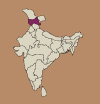
Kashmir Shaivism: Codified by Vasugupta (ca 800), this abheda--intensely monistic school--known as Pratyabhijna Darshana, explains the creation of soul and world as God Shiva's shining forth in His dynamic first impulse. As the Self of all, Shiva is immanent and transcendent, a real but abstract creator-preserver-destroyer. Founded in Kashmir. Abhinavagupta was an important figure in Kashmir Saivism.
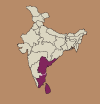
Shaiva Siddhanta: In Rishi Tirumular's monistic theism (ca -200), Shiva is material and efficient cause, immanent and transcendent. The soul, created by Shiva, is destined to merge in Him. In Meykandar's pluralistic realism (ca 1200), God, souls and world are beginningless and eternally coexistent. Shiva is efficient but not material cause. Highlighted are Andhra Pradesh, Tamil Nadu and Sri Lanka. Thirugnana Sambanthar, Thirunavukkarasar, Sundaramoorthy Nayanar and Manikkavasagar are considered the gurus of Shaivism. The hymns sung by the first three are collected into a book called Thevaram. The work of Manikkavasagar is called Thiruvasagam. These books are reverentially worshipped and recited by the devotees. The first three form part of the 63 Nayanmars, staunch devotees of Siva. Nayanars (or Nayanmars), saints from Tamil Nadu, and the Vira Shaivas or Lingayats from Karnataka lead a multi-caste mass movement that explained the devotional upsurge of Shaivite worship in early medieval South India.
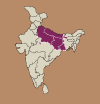
Siddha Siddhanta: Expounded by Rishi Gorakshanatha (ca 950), this monistic theism is known as bhedabheda, embracing both transcendent Shiva Being and immanent Shiva Becoming. Shiva is efficient and material cause. The creation and final return of soul and cosmos to Shiva are likened to bubbles arising and returning to water. Influential in Nepal, Uttar Pradesh, Bihar and West Bengal.
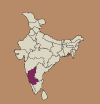
Lingayatism: Made popular by Basavanna (1105-1167), this version of qualified nondualism, Shakti Vishishtadvaita, accepts both difference and nondifference between soul and God, like rays are to the sun. Shiva and the cosmic force are one, yet Shiva is beyond His creation, which is real, not illusory. God is efficient and material cause. Influential primarily in Karnataka.
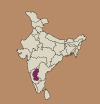
Shiva Advaita: This monistic theism, formulated by Srikantha (ca 1050), is called Shiva Vishishtadvaita. The soul does not ultimately become perfectly one with Brahman, but shares with the Supreme all excellent qualities. Appaya Dikshita (1554-1626) attempted to resolve this union in favor of an absolute identity—Shuddhadvaita. Its area of origin and influence covers most of Karnataka state.
Shaiva temples
There can be found almost innumerable Shaivite temples and shrines, with many shrines accompanied as well by murtis dedicated to Ganesha, Lord of the Ganas, followers of Shiva, and son of Shiva and Parvati.
The twelve Jyotirlinga shrines are among the most esteemed in Śaivism.[14]
Banalinga, called the Svayambhu Linga, is an aniconic form of worship among the shaivites and smartha brahmins.
There are many temples in Tamilnadu dedicated to Shiva, but the holiest of all Siva shrines is Chidambaram's famous Nataraja Temple. Shiva's consort, Parvati is also worshipped in temples to Shiva, along with his sons Ganesha and Murugan.
The Agamas are a set of twenty-eight books, written in Sanskrit. Each temple follows its own Agama. The architecture and layout, the locations of the images, and directions for methods of worship are all prescribed, and no deviation is allowed. Shiva temples have a tall multi-storied gopuram at the entrance and are enclosed in a high wall. The lingam resides deep within the temple compound of buildings, courtyards and gardens. The lingam and the special structure that houses it are placed in such a way as to face the compound entrance directly; only the sivacharya may enter this sanctum sanctorum but worshippers gather around to witness the rituals of ablution, decoration and offerings, to pray and sing, and to receive the ceremonial blessing. Around the sanctum sanctorum every Siva temple has at least one circumambulatory path, and a procession around this path is part of the devotional service. A stone statue of Siva as Teacher, the Dakshinamurthy faces south. Dakshinamurthy literally means "on the southern part of an outer perimeter path of the sanctum sanctorum".
"Shivacharyas" conduct Shiva worship services. Only the sivacharyas may enter the sanctum sanctorum, while worshippers gather at the entrance to watch. Unlike Catholic priests, sivacharyas are dedicated solely to worship and do not perform marriages or other civil rites of passage. In Chidambaram and a few other places adhisaivas are allowed to perform the ceremonies. Services are held daily, as many as six each day depending on the resources and the popularity of the temple. The usual service consists of the following: first, the figure of the deity is anointed with oil, water, milk, ghee, honey, curd, various juices, sandalwood paste, and others before being showered with blossoms. Then it is dressed in the traditional way of Tamilnadu, adorned with jewels and flower garlands. Incense is burned, followed by a food offering (usually a rice preparation). Beautiful lamps of various designs are lit and presented to the image of the deity. Camphor is lit and presented. The burning camphor is then carried to the congregation. The worshippers reverentially show their palms over it before placing their palms over their eyes, some say this gesture signifies that the devotion is as precious to the worshipper as his or her own sight. Finally sacred ash and kungumam are distributed into the upraised palms of the worshippers, who touch it onto their foreheads. The worshippers then process along the circumambulation at least once before bowing low in prayer before the sanctum sanctorum, singing and reciting verses from the Vedic hymns, the Thevaram and others.
Home worship
People also worship Shiva at home. They have natural lingam-shaped stones to which they perform ablution flower-worship and Nivedhanam, a type of food-offering.
It is also common to have small shrines or altars dedicated to Lord Shiva, with images of his sons Ganesha or Skanda, other household deities, or his consort.
Beyond India
Shaivism left a major imprint on the intellectual life of classical Cambodia, Champa in what is today south Vietnam, Java, Kashmir and the Tamil land. The wave of Saivite devotionalism that swept through late classical and early medieval India redefined Karnataka and Tamil Nadu. Shaivite worship legitimized several ruling dynasties in pre-modern India be they the Chola, the Rajput or tribal. A similar trend was witnessed in early medieval Indonesia with the Majapahit empire and pre-Islamic Malaya.[15][16]
See also
- History of Shaivism
- Shaiva Siddhanta
- Kaśmir Śaivism
- Lingayatism
- Vaishnavism
- Shaktism
Notes
- ↑ Tattwananda 1984, p. 45.
- ↑ For dating to 400-200 BCE see: Flood (1996), p. 86.
- ↑ For Śvetāśvatara Upanishad as a systematic philosophy of Shaivism see: Chakravarti 1994, p. 9.
- ↑ Flood (1996), p. 153.
- ↑ For Gupta Dynasty (c. 320 - 500 CE) and Puranic religion as important to the spread across the subcontinent, see: Flood (1996), p. 154.
- ↑ Apte, p. 714.
- ↑ Apte, p. 866
- ↑ For an overview of the Shaiva Traditions, see Flood, Gavin, "The Śaiva Traditions", in: Flood (2003), pp. 200-228.
- ↑ Tattwananda 1984, p. 54.
- ↑ For overview of Sanderson's method of grouping, see: Flood (2003), p. 206.
- ↑ For the classifiction of Sanderson into atimārga and mantramārga, and characterization of the Pāśupatas, Lākula, and Kālāmukhas, see: Flood (2003), p. 206.
- ↑ For the Pāśupatas as the oldest named Śaiva group, see: Flood (2003), p. 206.
- ↑ For Pāśupata as an ascetic movement see: Michaels (2004), p. 62.
- ↑ For a list of the twelve Jyotirlinga shrines, and mention of them in the Śiva and Skanda Puranas, see: Chakravarti 1994, pp. 139-140.
- ↑ Sastri, K.A. Nilakanta. "A Historical Sketch of Saivism", in: Bhattacharyya (1956), Volume IV pages 63 -78.
- ↑ For more on the subject of Saivite influence on Indonesia, one could read N.J.Krom, Inleiding tot de Hindoe-Javaansche Kunst/Introduction to Hindu-Javanese Art, The Hague, Martinus Nijhof, 1923
References
- Bhandarkar, Ramakrishna Gopal (1913). Vaisnavism, Śaivism, and Minor Religious Systems. New Delhi: Asian Educational Services. ISBN 81-206-0122-X. Third AES reprint edition, 1995.
- Bhattacharyya (Editor), Haridas (1956). The Cultural Heritage of India. Calcutta: The Ramakrishna Mission Institute of Culture. Four volumes.
- Chakravarti, Mahadev (1994), written at Delhi, The Concept of Rudra-Śiva Through The Ages (Second Revised ed.), Motilal Banarsidass, ISBN 81-208-0053-2
- Flood, Gavin (1996). An Introduction to Hinduism. Cambridge: Cambridge University Press. ISBN 0-521-43878-0.
- Flood, Gavin (Editor) (2003). The Blackwell Companion to Hinduism. Malden, MA: Blackwell Publishing Ltd.. ISBN 1-4051-3251-5.
- Keay, John (2000). India: A History. New York: Grove Press. ISBN 0-8021-3797-0.
- Tattwananda, Swami (1984), written at Calcutta, Vaisnava Sects, Saiva Sects, Mother Worship (First Revised ed.), Firma KLM Private Ltd.
